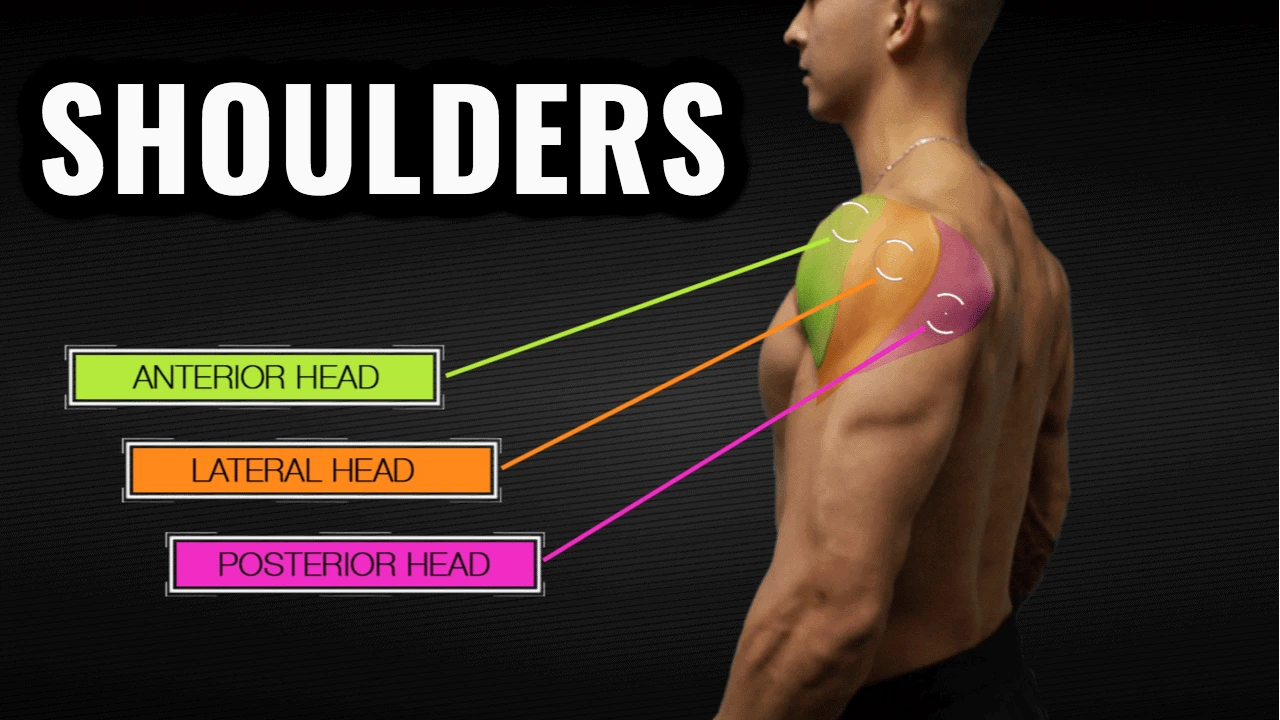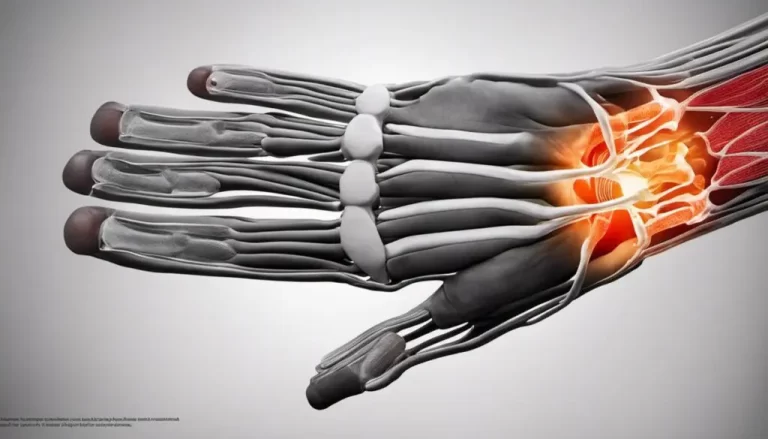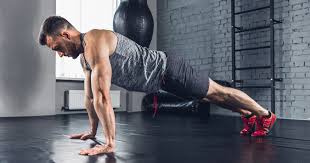Deltoid muscle exercise
Table of Contents
Introduction
- The deltoid muscle exercise strengthens your shoulders, upper back, and upper arms. It helps to improve posture and is beneficial for people who sit or do forward-bending movements very often. Improve the range of motion(ROM) and flexibility of your deltoid muscle, Reduce tension and tightness in your shoulders, Improve your body posture, reduces the chance of shoulder injury and sprain, and also Boost athletic performance.
- The Deltoid muscle is a large triangular-shaped muscle that lies over the shoulder joint and it gives the shoulder its rounded contour.
- Deltoid muscle contains three-part
- anterior or clavicular
- middle or acromial
- posterior or spinal
- The Deltoid muscle originates from the anterior border and the adjoining surface of the lateral one-third of the clavicle,
- the lateral border of the acromion process where four septa of origin are attached and the lower lip of the crest of the spine of the scapula. The Deltoid muscle is inserted on the deltoid tuberosity of the humerus. The nerve supply of The Deltoid muscle is the Axillary nerve (C5, C6). The blood supply of the deltoid muscle is the thoracoacromial artery (acromial and deltoid branches), the circumflex humeral arteries, and the profunda brachii artery. The multipennate acromial fibers are powerful abductors of the upper limb at the shoulder joint from the beginning to 90 degrees. A multipennate arrangement allows a large number of muscle fibers to be packed into a small volume. As the strength of contraction of a muscle is proportional to the number of muscle fibers present in it (and not on their length), a multipennate muscle is stronger than other muscles having the same volume. The anterior fibers are flexors and Internal rotators of the shoulder. The posterior fibers are the extensors and external rotators of the shoulder.
- Deltoid muscles act as an abductor of the shoulder and stabilizers of the humeral head. as well as assist in elevation forward.
- The deltoid is a very powerful muscle and is used in many ADLs and many athletic activities.
- Deltoid muscles include two types of exercise:
- Strengthening exercise
- Stretching exercise
Health benefits of Deltoid exercise:
- Shoulder strengthening exercises can promote healthy movement patterns and improve posture and muscle function.
- Performing these exercises on a regular base can help to treat and prevent shoulder injuries and allow you to move with greater ease and strength.
- The deltoid muscle exercise strengthens your shoulders, upper back, and upper arms.
- It helps to improve posture and is beneficial for people who sit or do forward-bending movements very often.
- Improve the range of motion(ROM) and flexibility of your deltoid muscle
- Reduce tension and tightness in your shoulders
- Improve your body posture
- It reduces the chance of shoulder injury and sprain
- Boost the athletic performance
Deltoid muscle strengthening exercise
There are too many variations of Deltoid muscle strengthening exercises you can do at Home and in the gym.
Variations of Deltoid strengthening exercises.
Anterior Deltoid Raise
Benefits: One of the best anterior deltoid exercises, this targets the anterior head of the deltoid muscle. This exercise helps to improve the strength needed to lift the objects in front of you.
- How to do it?
- Front Raise Exercise
- For this exercise, the Patient position is to Stand with your feet hip-width apart and grab a dumbbell in both hands with your arms by your sides.
- Your arms should be straight, then slowly lift the dumbbell directly in front of you at shoulder height with your palms facing each other.
- Slowly Lower back down to the starting position and then repeat.
- Do 2 to 3 sets of the 10 to 15 repetitions.
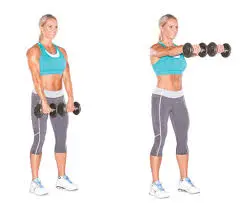
Callahan Press
Benefits: This exercise hits all three heads of the deltoid muscle, and a Callahan press helps with full-shoulder development.
- How to do it?
- For this exercise, the patient’s position is to stand with the feet hip-width apart and grab a dumbbell in both hands.
- Raise your arms out to your sides with your elbow bent up to 90 degrees.
- Your upper arms should be in line with your shoulder joint, then point your hand toward the ceiling. This is the initial position.
- then move your forearms in front of you and then turn your palms inside toward your face.
- Then reverse the motion to return to the beginning position.
- Press the weights directly above your shoulders, and then reverse the movement to return to the beginning position.
- That is one repetition.
- Do 2 to 3 sets of the 10 to 15 repetitions.
Jerk Press exercise
Benefits: The jerk press helps to build strength and power, and you use the deltoid muscle along with your trapezius and triceps.
- How to do it?
- For this exercise, you have to stand with your feet hip-width apart, and grab a pair of dumbbells in front of your shoulders, and palms facing each other. This is the initial position.
- In one explosive motion, press the weights overhead while jumping your right foot forward, and left foot back so you land in a high lunge.
- Step your front foot back to the starting position, bringing the weights back to shoulder height.
- Do 8 to 12 repetitions of 2 to 3 sets.
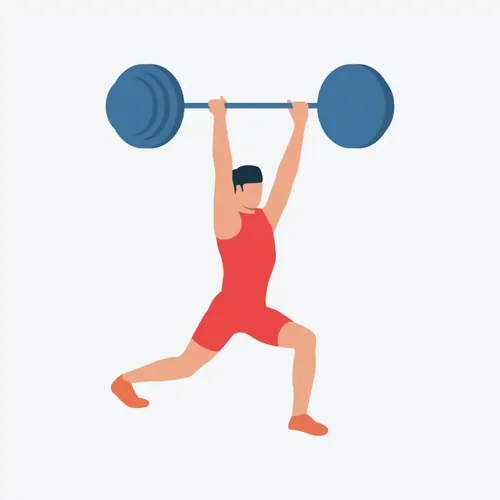
Hammer Curl to Press
Benefits: Not only does this combination movement work your deltoid muscle, but it also utilizes many other muscles in your upper limb, including your forearms, biceps, and triceps.
- How to do it?
- For this exercise, the patient position is to Stand with your feet hip-width apart, grab a dumbbell in both hands with your arms at your sides, palms facing each other.
- Your elbows should be tucked into your sides, and then curl your dumbbells upward towards your shoulders without moving your upper arms.
- Press the dumbbells above your head until your arms are extended, and your palms should be facing in front of each other.
- Lower the weights back down to your shoulders, then lower your arms all the way straight downwards to your sides.
- Do 10 to 20 repetitions of 2 to 3 sets.
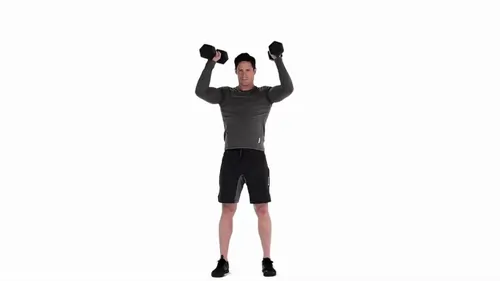
Bent-Over Lateral Raise (Reverse Fly)
Benefits: Even though the rear deltoid muscle gets employed during back exercises, they tend to be one of the least developed muscles on the body because people don’t target them specifically enough. This move is one of the best to target your posterior deltoid muscle. Be sure to maintain strict form to keep muscles engaged and keep your spine safe.
- How to do it?
- For this exercise, the patient position is to Stand with your feet hip-width apart and grab a dumbbell in both hands at your sides.
- Hinge at your hips, your back should be flat, and allow your arms to hang straight down with your palms facing towards each other.
- With elbows slightly bent, raise your arms out to the sides until they are parallel to your back. Slowly lower the dumbbells and then repeat.
- Do 10 to 20 repetitions of 2 to 4 sets.

Seated EZ Bar Underhand Press
Benefits: This move may seem simple, but you are working the anterior head of your deltoid muscle, your triceps, and your serratus anterior (the muscle under your shoulder blade that covers your ribs), all to build strength in and improve stability of the shoulder.
- How to do it?
- Adjust an incline bench so the back is vertical and sit on a seat.
- Load an EZ Bar and hold it in the middle with an underhand grip. bent your arms to bring the bar underneath your chin.
- Press the bar directly overhead until your arms are in extension.
- Slowly bring the barbell back down right below your chin, and then repeat.
- Do 18 to 20 repetitions of 2 to 3 sets.
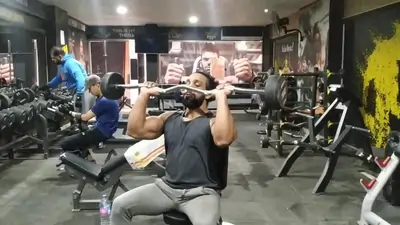
Upright Row to Hip Fly
Benefits: This two-part move targets the medial heads of your deltoid muscle, your trapezius, and your biceps, all of which help build pulling strength.
- How to do it?
- For this exercise the patient position is to Stand with your feet hip-width apart, grab a pair of dumbbells in front of your thighs, palms facing you.
- Your chest should be up and your core muscle engaged, lift the dumbbells to your chin in an upright row.
- Your elbows should not raise above your shoulder height.
- Bring your arms down to your sides, bent your knees, push your hips back, and hinge forward into a flat back.
- Let your arm hang straight with your palms facing backward.
- Your arm should be straight and your shoulder blades pulled backward, then raise the dumbbells behind you.
- Lower your arms and repeat.
- Performed 10 to 20 repetitions of 2 to 3 sets.

Decline Push-Up
- How to do it?
- The Decline push-up is traditionally known for building the strength of pectoral muscles in your chest. This push-up is an advanced variation of the standard push-up that works the anterior deltoids with greater intensity.
- For this exercise, you have to Lie on the floor in a prone position with the hands planted around shoulder-width.
- Place your feet on an elevated platform such that the body forms an acute angle with the floor.
- The elbows should be bent, and the torso should only be centimeters away from the floor.
- Elevate your upper limb until the arms are fully straightened and perpendicular to the floor. Hold at that point for 2 seconds then return to the beginning position.
- Do 10 to 20 repetitions of 2 to 3 sets.
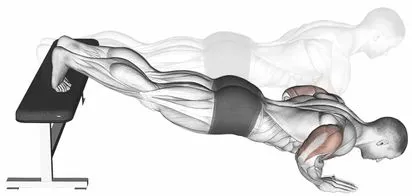
Walking Plank
- How to do it?
- For this exercise, you have to start with a high plank position.
- Bracing through the core, move your left hand and left foot out 6 to 7 inches.
- Bring your right foot and right hand to meet it.
- Slowly move left for 15 to 20 seconds, then return to the starting position to complete the set.
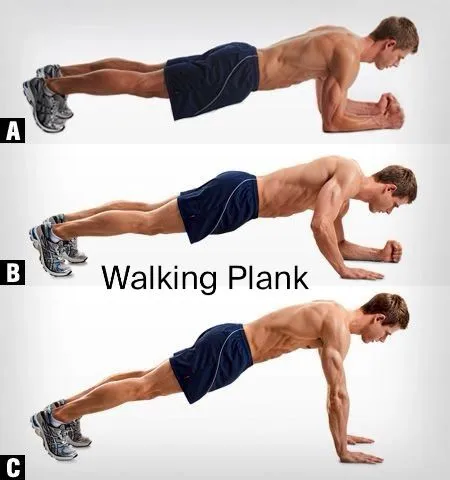
Face Pull exercise
- How to do it?
- The patient position is Kneeling with your left foot forward in front of a cable machine.
- Grab the handles with your palms facing in and pull them toward your face drawing your hands apart.
- Hold at that point for a couple of seconds, then return to the beginning position.
- Do 10 to 20 repetitions of 2 to 3 sets.
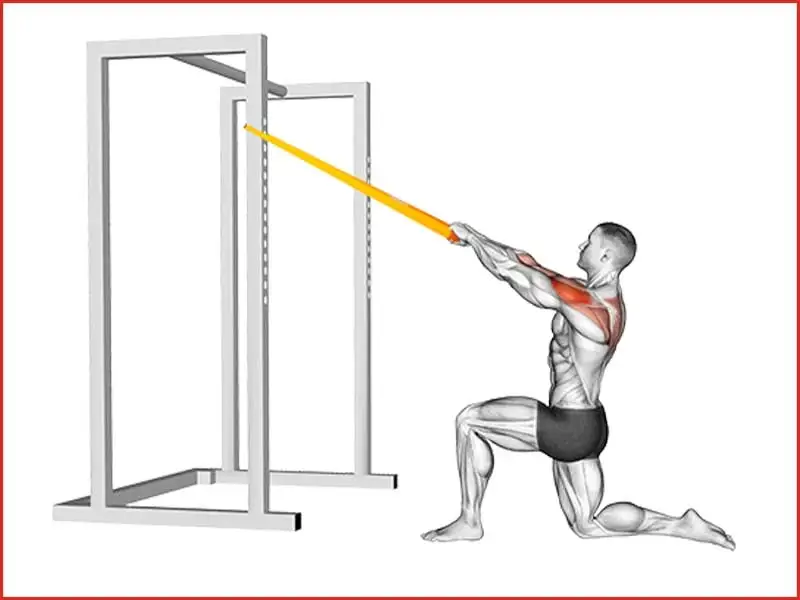
Barbell upright row
- How to do it?
- The barbell upright row works the anterior and middle heads of the deltoid muscle.
- For this exercise, the patient position is to Stand with your shoulder-feet width apart. grab the barbell and allow it to hang in front of you at the length of your arms. Keep Your palms facing your body and your hands in line with your thighs.
- Inhale and brace the abdominals. your back should be straight, your chest up, and your eyes focused forward.
- Lift the bar straight up (toward the chin) with the breath out.
- Lead with the elbows and keep the barbell close to your body.
- Your arms should go no higher than your shoulders height; okay to slightly less.
- Hold at the top of the lift for two to three seconds.
- Lower the bar as you breathe in, returning it to the starting position.
- Do 10 to 15 repetitions of 1 to 2 sets.
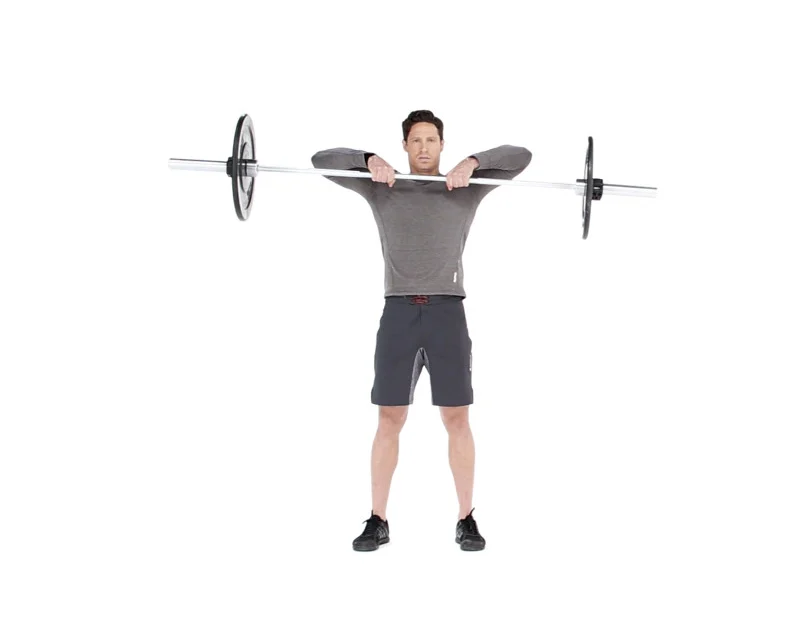
Side-lying external rotation
- How to do it?
- The side-lying external rotation focuses on the outer movement that is performed by the posterior part of the deltoid muscle. It also works on some rotator cuff muscles (infraspinatus and teres minor muscle).
- For this exercise, you have to lie on your right side, holding a lightweight dumbbell in your left hand.
- Place your left arm on your side with your elbows bent at 90 degrees. If you have broad shoulders, place a rolled towel just between your upper arm and your trunk.
- Then rotate your arm on the trunk as far as you can without letting your upper arm drift off from the body.
- Hold for 2 to 4 seconds, and then slowly lower it back to the initial position. performed 10 to 15 repetitions for 2 to 3 sets.
Assisted pull-up exercise
- How to do it?
- This is a very effective exercise, but most people do not have the upper limb strength to perform one without a small help.
- This movement works not only on your posterior part of the deltoid muscle but also work on your lattisimus dorsi, trapezius, and biceps muscle.
- Adjust the weight deduction on the side of the machine if you want. Choose the correct amount and set it. Climb onto the knee pad and push it down until it’s low enough for you to place both side knees on.
- You have to Keep Your knees up to hip-width apart. Then Hold the outer handles above you, your palms should be facing away from the center.
- Straighten your arms and lower yourself to the begging position. Pull your body up until your chin is level above or with the handles.
- Hold the position for some second seconds, then lower yourself down with control.
- Focus on keeping your shoulder blades contracted. They should be pressed backward and down.
- Start with 8 to 10 repetitions and work up to 12 to 15 repetitions.

Sumo Circle Chop
Benefits: This total-body move employs your quadriceps, gluteus, all 3 parts of the deltoid muscles, and your obliques.
- How to do it?
- For this exercise the patient position is to Stand with your legs wide, toes turned out 45 to 50 degrees, and grab the dumbbell with both hands in front of your chest. This is an initial position.
- Push your hips backward as you slowly lower down to the sumo squat, your back should be straight.
- then Push through the heels to extend your legs.
- Starting from the right side, circle the dumbbell around your head, rotating it around and then back to the right.
- As you bring the dumbbell to the front, continue the movement and pivot both feet to your right.
- Flex both knees into a lunge and straighten your arms to lower the dumbbell in front of your front knee slowly.
- Extend your legs and pivot back to the starting position, and move the dumbbell back in front of your chest. Repeat on the left side.
- Performed 10 to 20 repetitions of 2 to 3 sets.
Deltoid Stretching exercise
If you are doing regular strengthening, it is also important to stretch the deltoid muscles at regular intervals to maintain flexibility of the muscles. Regular strengthening and stretching exercises of the deltoid muscle are equally important.
List of deltoid stretching exercises
There are some of the deltoid stretching exercise lists are:
- Anterior deltoid stretch
- Lateral deltoid stretch
- Posterior deltoid stretch
- Dynamic bear hug stretch
- Modified downward dog
How to stretch the deltoid?
If you want to stretch your deltoid muscles, the following exercise is the best exercise you can do at home.
Anterior deltoid stretch
- How to do?
- The patient position is to Stand straight with feet hip-width apart, your shoulders relaxed so that your scapulae are tucked down along with either side of your spine.
- Clasp your palms behind your back, then raise them away from your body while your elbows are straight. When you feel stretched stop there and hold the position for 15 to 30 seconds.
- Don’t bend your body at any level during motion and stand upright.
- If you have a problem clasping your palms behind then hold a towel between the palms.
- Perform this stretch 2 to 3 times.
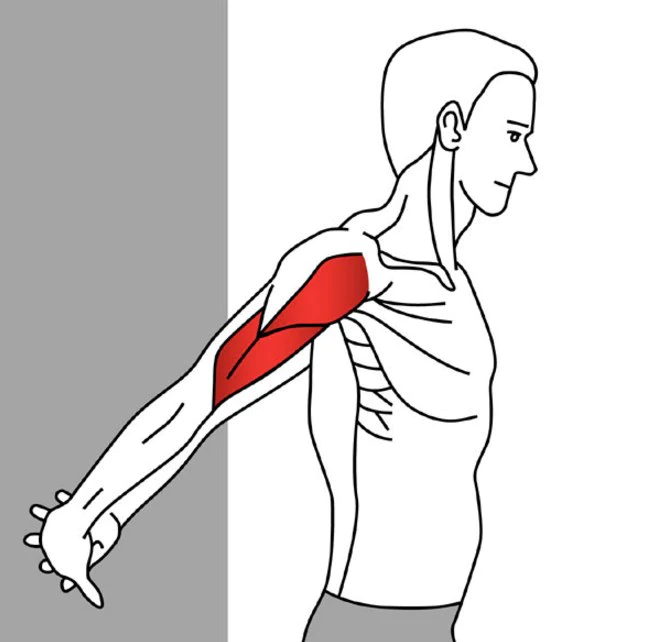
The anterior deltoid stretch has some variations:
- Isolation of internal rotation
- Doorway stretching
- Bridge position stretch
Isolation of internal rotation
Isolate internal rotation to target only the anterior deltoid muscle.
- How to do?
- The position of the patient is supine lying with your arms extended away from your shoulders. Firstly Lift your one hand so that your elbow joint is at a 90-degree position and your forearm is at a right angle of your body. Then Slowly put down your hand until it is resting on the side of your body. Hold that stretch for some second, then return to begin.
- Perform 3 to 4 sets of 20 repetitions. Do it on another arm.
- Lower your arm as far as you can reach without any type of pain.
- In advance, you can lift weights such as a dumbbell during the stretch.
Doorway stretching
- How to do?
- The patient’s position is Standing straight in a doorway with feet hip-width apart.
- Place your right palm on a doorway slightly lower to your shoulder level, the elbow is bents lightly.
- Turn your body away from your right arm. When you feel stretched then hold that position for 10 to 20 seconds. Then do it on another side.
- You can use any stable object for holds such as a vertical bar, or wall.
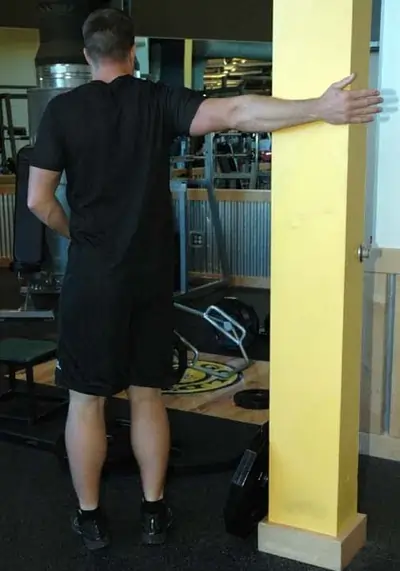
Lateral deltoid stretch
- Lateral deltoid stretch is also called cross-body deltoid stretch.
- How to do –the patient position is to Stand straight with your feet hip-width apart. Now position your left hand across your body or horizontally to the body with your elbow slightly bent.
- Grasp at the end of your upper arm just above your elbow with your right hand.
- Then push the left hand towards your body with the right hand.
- When you can feel stretched, hold that position for 30 seconds. Then perform this exercise on the other side.
- During the motion, your shoulder should be in a relaxed position.
Lateral deltoid stretch has some variations:
- 1. How to do? – Take a standing position with your foot around hip-width apart, next to a table or bench.
- Lean forward, and then place your left hand on a table for support.
- Now slowly swing your right arm forward and backward like a pendulum, which is hanging on the side of the table.
- Don’t move your body while motioning. Your back should be straight and your knee is bent slightly. Now repeat the motion side to side than in a circular movement.
- Turn around and do it on your left arm.
- Do 2 sets of 10 repetitions.
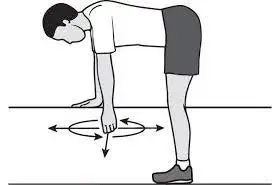
- 2. How to do? – Stand straight, your back should be straight, and your feet are around hip-width apart.
- Place your right arm behind the back with 90-degrees of elbow bent. Then hold that elbow by the left elbow.
- Then pull your right elbow towards your left back with the left hand.
- When you can feel stretched, hold that position for 15 to 30 seconds.
- Repeat it on the left hand.
- Do 3 sets on each side.
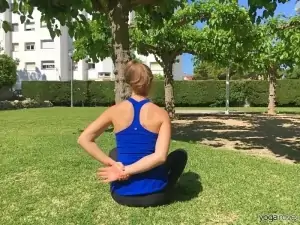
Posterior deltoid stretch
- How to do? – Start with a crossover stretch. Relax the shoulders, and pull them back so that your scapulae fall on each side of the spine.
- Reach one horizontally of your body and grasp with the other hand at your upper arm.
- Then Slowly start pulling that arm against your chest and opposite side. When you feel stretched stop there.
- Hold this position for 30 seconds and repeat on the other side of the arm.
- Do 4 repetitions on both sides.

The posterior deltoid stretch has some variations:
- Sleeper stretch
- Bent over horizontal abduction stretch
Sleeper stretch
- How to do?
- It activates supporting muscles. The patient position is the side-lying position with your lower arm 90 degrees bent so that the forearm is at a right angle to your body.
- Use your other arm to push your arm downward. If you can feel stretched then hold that position for 30 seconds, then give rest for another 30 seconds.
- Repeat this stretch on another side of the arm. Don’t bend or press on your wrist during the stretch.

Bent over horizontal abduction stretch
- How to do?
- The patient’s position is prone lying at the edge of the bench or bed so that one arm hangs out of the bench.
- Begin with straight your hanging arm, then gently lift it to your eye level, without bending your arm.
- Now slowly lower down to the initial position.
- Do 3 sets with 10 repetitions. now switch to the other side of the arm.
- Only lift your arm as much as you can without feeling any type of pain. Once you master it then you can add some weight.
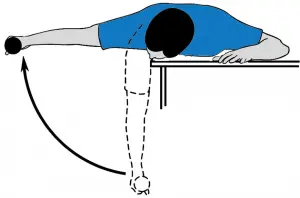
Dynamic bear hug stretch
- This exercise stretches your anterior and posterior parts of the deltoid muscle and also your chest muscles.
- This is the best movement to perform before the workout.
- How to do this stretch – Patients position is to Stand straight with your feet shoulder-width apart. Make sure to engage your abdominal muscle and that your posture is straight.
- Reach your arm out and wide, at 90 degrees of the abduction.
- When you can feel a stretch in front of the shoulders and chest then bring the arms across the chest. Try to hug yourself, so that your left arm is on top of your right arm. You can feel a stretch on the back of the shoulder.
- In a controlled movement, swing your arm in the beginning position. Try to reach the end motion before your arms go back to the hugging position. This time your right arm is on top of your left side arm.
- Perform it for 30 seconds, then take a rest. repeat 2 more rounds.
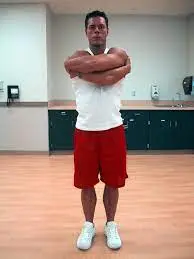
Modified downward dog
- The modified downward dog is targeted the chest and anterior part of the deltoid muscle. And it’s the best way to improve your posture because it also stretches your low back, glutes, and hamstrings muscle.
- also, it’s easy to perform at your workplace because this stretch is comfortable.
- How to do this stretch – Patients position is to Stand straight behind a stable desk, chair, or table. Place your feet around hip-distance apart.
- Now engage the abdomen and stand with a good posture.
- Put your hands flat on the desk with your arms fully straight.
- Make sure to straighten up your arms, back and legs during the stretch, only your hips are bending.
- Take deep breathing, and then start walking backward until your body forms an inclined line. Now tip your upper body forward and the hips backward. Extend your arms over the head as you go walk backward.
- When you can feel stretched at the front of the shoulders and chest then hold that position.
- Hold that for 30 seconds. Release and repeat it two times.
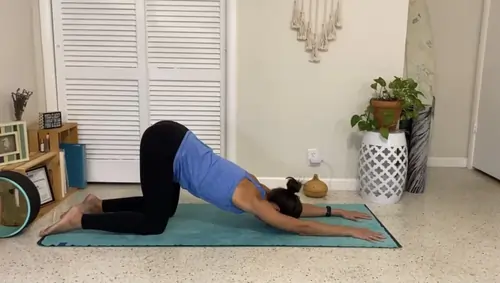
Bridge position stretch
- How to do?
- The patient’s position is sitting. Bend your both knees and the feet should be flat on the floor.
- Your hand is next to your body and your fingers are pointing forward.
- Take a breath and press your feet and hands against the floor while lifting your body into the bridging position. Your upper body and thighs should parallel to the floor. Straighten your legs one at a time without lower down your hips to do the bridging position. Now relax the neck and lower your head.
- Hold this position for 30 seconds, then reverse the motion and take the beginning position.
- Beginners start with 5-second holds then gradually you can increase the time.
- When you hold a position breathe in through your nose and breathe out through your mouth, and it should be slow and deep.
Safety and precautions during Deltoid muscle stretching exercise
There are some tips to provide safety during the stretching of the deltoid muscle.
- Deltoid muscle stretch may be uncomfortable, especially when you are stiff. Do not try to stretch at your painful level.
- Don’t bounce. Ballistic stretching is dangerous, so avoid bouncing during your stretches unless suggested by your physiotherapist.
- Go gently. Mostly, stretches are slow and gentle, so don’t race to complete the stretch.
- If you have a prior injury, such as an acute or chronic one, try stretching after your physiotherapist’s suggestion.
- If you are not able to do the stretch perfectly, don’t force yourself to do it.
- If you have any fracture around your shoulder joint then do not perform the stretch.
When do not do the Deltoid muscle exercise?
- If you are already suffering from pain in the shoulder then you should avoid painful exercise.
- If your doctor advised you to rest.
- If your arm bone is fractured recently.
- If you have pain in your back then avoid weight-lifting exercises.
- Avoid too much exercise.
- Avoid heavy lifting exercises. Gradually increase the repetition and weight of the Dumbells.
- If you feel any pain in your shoulder or discomfort during this exercise.
- If you have any pain, sprain or bursitis then do not perform it.
Deltoid exercises at home
- Walking Plank. Start in a high plank position
- Upright Row. Hold a dumbbell on both sides hands, resting in front of your thigh
- Rear Delt Fly
- Lateral Raise
- Plank With Shoulder Taps
- Burpee
- Single-Arm Dumbbell Press
- Rear Delt Fly
Deltoid exercises for women
- Dumbbell Front Raise. It targets the anterior deltoid and pectoralis muscles and is stabilized by the core
- Dumbbell Lateral Rais
- Overhead Shoulder Press
- Bent Over Reverse Fly
- Dumbbell Arnold Press
- Upright Row
Deltoid exercises without weights
- Pike Push-ups. This exercise starts in a push-up position with your arms straight and hands shoulder-width apart
- Handstand Push-ups. Starts this exercise by standing in front of a wall
- Wall Walks
- Incline Push-ups
- Shoulder Taps
- Bear Crawls
- Plank Rockers
- Plank Walks
Deltoid exercises with dumbbell
- Side lateral press
- Overhead press
- Arnold press
- Dumbells shoulders press
- Reverse fly
- Front rise
Deltoid stretch
- Anterior deltoid stretch
- Isolation of internal rotation
- Doorway stretching
- Bridge position stretch
- Posterior deltoid stretch
- Sleeper stretch
- Bent over horizontal abduction stretch
- Lateral stretch
- Dynamic bear hug stretch
- Modified downward dog
Rear deltoid exercises
- Dumbbell Reverse Fly
- Resistance Band Face Pull
- Inverted Row
- Dumbbell Bent-Over Row
- Dumbbell Y-T-I Raise
- Dumbbell Arnold Press
- Bodyweight Cobra on Stability Ball
Lateral deltoid exercises
- Lateral deltoid stretch is also called cross-body deltoid stretch.
- How to do –the patient position is to Stand straight with your feet hip-width apart. Now position your left hand across your body or horizontally to the body with your elbow slightly bent.
- Grasp at the end of your upper arm just above your elbow with your right hand.
- Then push the left hand towards your body with the right hand.
- When you can feel stretched, hold that position for 30 seconds. Then perform this exercise on the other side.
- During the motion, your shoulder should be in a relaxed position.
Lateral deltoid stretch has some variations:
- 1. How to do? – Take a standing position with your foot around hip-width apart, next to a table or bench.
- Lean forward, and then place your left hand on a table for support.
- Now slowly swing your right arm forward and backward like a pendulum, which is hanging on the side of the table.
- Don’t move your body while motioning. Your back should be straight and your knee is bent slightly. Now repeat the motion side to side than in a circular movement.
- Turn around and do it on your left arm.
- Do 2 sets of 10 repetitions.
- 2. How to do? – Stand straight, your back should be straight, and your feet are around hip-width apart.
- Place your right arm behind the back with 90-degrees of elbow bent. Then hold that elbow by the left elbow.
- Then pull your right elbow towards your left back with the left hand.
- When you can feel stretched, hold that position for 15 to 30 seconds.
- Repeat it on the left hand.
- Do 3 sets on each side.
Front deltoid exercises
- Front raise
- Arnold press
- Front cable raise
- Barbell front raise
- Dumbell front raise
FAQ
The Best Exercise for your deltoids is Arnold Press Start this v-shaping exercise in a sitting or standing position, with your feet hip-width apart. Burpee, Dumbbell Upright Row, Dumbbell Lateral Raise, Dumbbell Shoulder Press (Overhead Press/Military Press), Face Pull, Rear Delt Fly, and T Push-Up.
Overhead Press (Emphasizes Front + Lateral Delt). The overhead press is an essential compound movement when it comes to training the shoulder. This is due to the ability to easily overload it with weight and target all heads of the deltoid muscle.
Front Deltoid Raise Exercise: For this exercise, the Patient position is to Stand with your feet hip-width apart and grab a dumbbell in both hands with your arms by your sides.
Your arms should be straight, then slowly lift the dumbbell directly in front of you at shoulder height with your palms facing each other. Slowly Lower back down to the starting position and then repeat. Do 2 to 3 sets of the 10 to 15 repetitions.
To build your deltoids fast you can do Barbell High Row. 6 to 12 repetitions Moderate to heavy weight, and Dumbbell Incline Row. 6 to 12 repetitions Heavyweight, Lying Facepull. 10 to 15 repetitions Lighter weight, and Rear Delt Cable Pull. 15 to 20 repetitions Lightweight.
To work your deltoids without weights you can do Pike Push-ups Start with a push-up position with your arms straight and hands shoulder-width apart, Handstand Push-ups start this shoulder exercise by standing in front of a wall, Wall Walks, Incline Push-ups, Shoulder Taps, Bear Crawls, Plank Rockers and Plank Walks.

